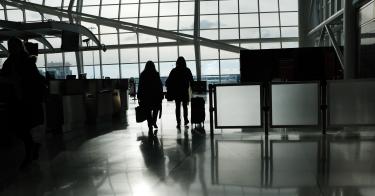As the State Department warns Americans not to travel internationally and advises all Americans abroad to return home or prepare to shelter in place, the U.S. continues to expand travel restrictions as a key component in the fight against the coronavirus.
That advisory Thursday afternoon from the State Department comes a day after the joint announcement by the United States and Canada that our common border is closed temporarily.
Flattening the coronavirus infection curve, or reducing the numbers, through social distancing, good public hygiene, and well-considered travel restrictions provides real potential benefits.
Besides lowering the number of COVID-19 cases, these benefits include saving the lives of the most vulnerable and reducing the stress and strain on the health care system from the coronavirus pandemic.
Travel Advisory: Level 4 - The Department of State advises U.S. citizens to avoid all international travel due to the global impact of #COVID19. In countries where commercial departure options remain available, U.S. citizens who live in the US should arrange for immediate return. pic.twitter.com/MydSzFffYd
— Travel - State Dept (@TravelGov) March 19, 2020
As the volume of COVID-19 cases spreads from the origin of the new virus in Wuhan, China, across the globe, Washington has added appropriate travel restrictions with the goal of reducing the flow of the infected into this country.
It makes sense.
Not surprisingly, other countries have started imposing similar travel restrictions, including most recently in Europe, now the epicenter of the coronavirus infection outside China, and where travel previously was unrestricted in the 26 Schengen Area countries.
Singapore, Hong Kong, and Taiwan, front-line states that seemingly battled the coronavirus successfully early on, are experiencing a resurgence of the outbreak. Why? Infected travelers returning from abroad, including vacationers.
With the onset of symptoms appearing from two to 14 days after exposure, airport health checks may not be sufficient.
It is not just these countries and territories that are being affected by travel.
China, which seemed to be beyond the peak infection point and into a recovery, reported 13 new cases Tuesday, down from 21 a day earlier. Of the new cases, 12 involved travelers arriving from abroad.
It’s clear that travel and the imposition of restrictions have a role in the course of the spread of viral infection.
So it’s surprising that the Trump administration was criticized for its first coronavirus-related travel restriction on Jan. 31, when officials suspended entry into the United States by any foreign nationals who had traveled to China in the prior 14 days. Excluded were the immediate family members of American citizens or permanent residents.
Appropriately, the administration took another important step against Iran.
In following data around the world, the Centers for Disease Control and Prevention determined that Iran was experiencing sustained person-to-person transmission of the coronavirus.
As of Feb. 28, Iran had 388 cases of the new coronavirus disease, COVID-19, a significant increase. The World Health Organization reported that 97 cases of COVID-19 had been exported from Iran to 11 other countries.
That day, the Centers for Disease Control and Prevention raised its infectious disease alert to Level 3, its highest level, which recommends travelers avoid all nonessential travel to Iran. On Feb. 29, President Donald Trump acted to restrict travel from Iran, similar to the action on China
The outbreak in Europe also warranted action.
The World Health Organization determined that multiple countries within the open border countries of Europe (the so-called Schengen Area) were experiencing sustained person-to-person transmission of the virus, with the largest number of confirmed COVID-19 cases outside China.
Trump issued a proclamation March 11 restricting travel from the Schengen Area and noting that the free flow of people among those 26 countries makes it difficult to manage the spread of the virus.
With concern increasing, Trump added the United Kingdom and Ireland to the travel restrictions in a March 14 proclamation after the CDC determined that the U.K. and Ireland were experiencing widespread, ongoing person-to-person transmission of the virus.
The WHO reported March 13 that the U.K. had 594 cases of COVID-19, five times more than seven days earlier, and that Ireland had 70 cases, also five times more than a week earlier.
Again, the president noted Ireland’s open border with the U.K. and the same challenges that the Schengen Area posed for suspending and limiting entry to the U.S.
On Wednesday, the U.S. and Canada jointly announced that the common border is closed to nonessential travel.
Canada reports approximately 600 confirmed and probable cases of COVID-19, 74% of which are travelers and 11% are those who had close contact with travelers.
The data clearly shows that international travel is contributing to the spread of the coronavirus to other countries.
Temporary travel restrictions work to stem that spread.
Indeed, the United States and other countries need to look continuously at others parts of the world where the virus is and will spread, and consider additional travel restrictions, including with Mexico.
If we’re going to beat this virus, we can’t chase the infection curve; we need to stay ahead of that curve to flatten it and save lives.
This piece originally appeared in The Daily Signal




